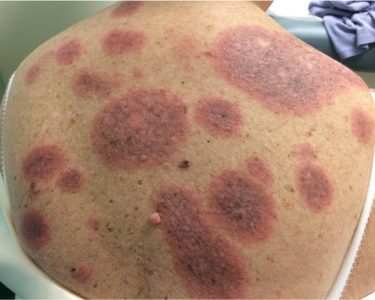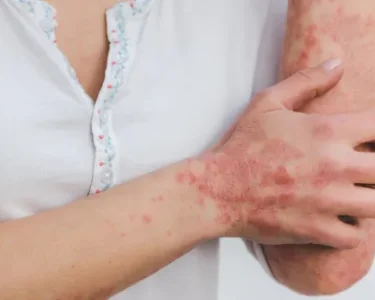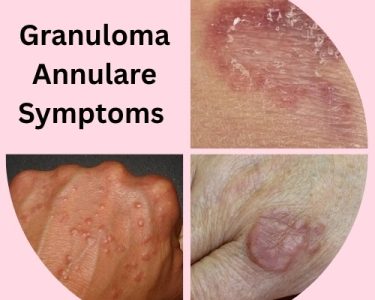Introduction
Granuloma annulare is a skin condition characterized by raised, ring-shaped bumps on the skin. While it is not a serious health concern, it can cause discomfort and self-consciousness in individuals affected by it. Over the years, researchers and medical professionals have been working diligently to develop new and improved treatments for granuloma annulare to alleviate its symptoms and provide patients with much-needed relief. We will explore the latest breakthroughs in the treatment of granuloma annulare in 2023. From innovative therapies to emerging research, we will delve into the cutting-edge solutions that offer hope for those struggling with this condition.
What Is Granuloma Annulare?
Granuloma annulare is a non-contagious skin condition characterized by the formation of ring-shaped bumps on the skin. These bumps, also known as granulomas, can appear on various parts of the body, including the hands, feet, wrists, and ankles. In most cases, granuloma annulare is asymptomatic, meaning it does not cause any physical discomfort. However, some individuals may experience itchiness or tenderness in the affected areas.
Causes and Risk Factors
The exact cause of granuloma annulare remains unclear, but several factors are believed to contribute to its development. Some potential causes and risk factors include:
- Genetic predisposition: There may be a genetic component that increases the likelihood of developing granuloma annulare.
- Autoimmune disorders: Certain autoimmune conditions, such as rheumatoid arthritis or diabetes, have been associated with granuloma annulare.
- Skin injuries: Granuloma annulare lesions may appear at the site of a previous skin injury, such as a cut or insect bite.
- Viral infections: In some cases, granuloma annulare has been linked to viral infections, including hepatitis C and HIV.
Symptoms and Diagnosis
Granuloma annulare presents as smooth, firm, and raised bumps that form a ring-shaped pattern on the skin. The bumps are usually flesh-colored or reddish and can range in size from a few millimeters to several centimeters in diameter. While the condition is typically not painful, some individuals may experience mild itchiness or tenderness. Granuloma annulare is usually diagnosed through a physical examination by a dermatologist. In some cases, a skin biopsy may be performed to confirm the diagnosis.
Conventional Treatment Options
Conventional treatment options for granuloma annulare primarily aim to manage the symptoms and reduce the appearance of the lesions. While these treatments can be effective for some individuals, they may not work for everyone.
Topical Steroids
Topical steroids are commonly prescribed to reduce inflammation and itchiness associated with granuloma annulare. Herbal Remedies for Granuloma Annulare is available in various strengths and formulations, including creams, ointments, and gels. Applying topical steroids directly to the affected areas can help alleviate symptoms and promote the healing of the lesions.
Cryotherapy
Cryotherapy involves the use of liquid nitrogen to freeze the granuloma annulare lesions. By freezing the affected skin, the abnormal cells are destroyed, allowing healthier skin to regenerate. Cryotherapy is a relatively quick and straightforward procedure that can be performed in a dermatologist’s office.
Intralesional Steroid Injections
In cases where granuloma annulare lesions are resistant to topical treatments, intralesional steroid injections may be recommended. This procedure involves injecting a corticosteroid medication directly into the lesions. The steroid helps reduce inflammation and shrink the size of the granulomas, leading to symptom improvement.
The Need for New Treatment Approaches
While conventional treatments can provide relief for some individuals with granuloma annulare, there is a need for more effective and targeted treatment options. Many patients continue to experience persistent symptoms or have recurring lesions despite following the conventional treatment approaches. This has led researchers and medical professionals to explore new avenues for managing and treating this challenging condition.
Cutting-Edge Research and Breakthrough Therapies
Targeted Immune Modulators
As granuloma annulare is believed to involve immune system dysfunction, targeted immune modulators have emerged as a promising treatment approach. These medications work by modulating the immune response and reducing the abnormal immune activity that contributes to the development of granuloma annulare. Biologic agents, such as tumor necrosis factor-alpha (TNF-α) inhibitors, have shown promise in early studies and clinical trials.
Photodynamic Therapy
Photodynamic therapy (PDT) is a treatment option that utilizes a combination of light and a photosensitizing agent to target and destroy abnormal cells. In the case of granuloma annulare, PDT can selectively destroy the granulomas while minimizing damage to healthy skin. This innovative therapy has shown positive results in several studies, demonstrating its potential as a safe and effective Herbal Treatment for Granuloma Annulare.
Topical Calcineurin Inhibitors
Calcineurin inhibitors, such as tacrolimus and pimecrolimus, have traditionally been used in the treatment of eczema and other inflammatory skin conditions. However, recent research has explored their potential efficacy in managing granuloma annulare. These topical medications work by suppressing the immune response and reducing inflammation in the affected areas. Preliminary studies have shown promising results, highlighting the possibility of repurposing these medications for granuloma annulare treatment.
Frequently Asked Questions
Is granuloma annulare a contagious condition?
No, granuloma annulare is not contagious. It cannot be transmitted from one person to another through direct contact or other means. It is important to note that granuloma annulare is not related to any infectious agent or external factor.
Can diet affect the development of granuloma annulare?
There is currently no scientific evidence to suggest that diet plays a significant role in the development or progression of granuloma annulare. However, maintaining a balanced and healthy diet is always beneficial for overall well-being and skin health.
What lifestyle changes can help manage granuloma annulare?
While there are no specific lifestyle changes that can cure granuloma annulare, certain measures may help manage the condition and minimize its impact. These include:
Keeping the affected areas clean and moisturized
Avoiding excessive sun exposure and using sunscreen
Managing stress levels, as stress can potentially exacerbate symptoms
Wearing loose-fitting clothing to prevent irritation of the lesions
Is granuloma annulare more common in children or adults?
Granuloma annulare can affect individuals of all ages, but it is more commonly seen in children and young adults. However, it can occur at any age, and the prevalence may vary among different populations.
Can stress worsen the symptoms of granuloma annulare?
While stress does not directly cause granuloma annulare, it is believed that stress can potentially worsen the symptoms. Stress has been associated with immune system dysregulation, which may exacerbate the underlying immune dysfunction in granuloma annulare. Managing stress through relaxation techniques, exercise, and seeking support can help minimize symptom flare-ups.
What are the long-term complications of granuloma annulare?
Granuloma annulare is generally a benign condition with no significant long-term complications. In most cases, the lesions gradually disappear on their own within a few months to a few years. However, in rare instances, scarring or pigmentation changes may occur in the affected areas. Regular follow-ups with a dermatologist can help monitor the condition and address any concerns.
Conclusion
In conclusion, the treatment landscape for granuloma annulare is continuously evolving, with new advancements and breakthrough therapies offering hope for individuals affected by this skin condition. From targeted immune modulators to photodynamic therapy and topical calcineurin inhibitors, researchers are exploring innovative approaches to better manage and treat granuloma annulare. While conventional treatments remain the mainstay, these emerging therapies show great promise in improving symptom control and enhancing the quality of life for those living with granuloma annulare. Continued research, clinical trials, and collaborations between medical professionals and researchers will pave the way for further advancements and a brighter future for individuals battling this troublesome skin condition.




